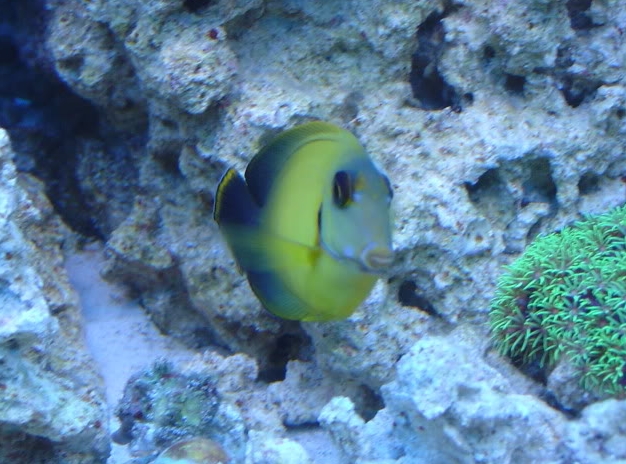
Mimic Tangs
The below profile is on one of the more interesting tangs that I have kept and is based on what I have learned and observed.
General Info:
Common Name: Mimic Tangs,
Scientific Name: Acanthurus Pyroferus (Yellow Mimic Tang), Acanthurus Tristis (Eibli Mimic Tang)
Reef Safe: Yes
Temperament: Can be Semi-Aggressive
Care Level: Easy to Moderate
Max Size: 10 in / 25 cm (7 to 8 inches is more common)
Appearance:
These tangs have many common names that used in the hobby. The Mimic Lemon Peel Tang (Acanthurus Pyroferus) is also known as: Yellow Mimic Tang, Lemon Head Tang, Mimic Surgeon, Chocolate Tang, Chocolate Surgeonfish, Heraldi, Lemon Peel tang, Half-Back Minic Tang, and Harold’s Mimic Tang. The Ebli Mimic Tang (Acanthurus Tristis) is also known as: Indian Ocean Mimic Surgeonfish, Thorntail Fish, and the Ebli Surgeonfish,
The juveniles will look like a juvenile angelfish, as they will mimic the most common dwarf angel in the area they are born in. This is where the term “mimic” comes from. Most of the time, they are so good at mimicking a certain angelfish, it is very hard to tell them apart until they start to mature and develop their adult appearance. There are a few different ideas about why this tang has evolved to mimic other fish when young. The most common theory is the mimic tang does this for protection while it continues to grow and develop.
The only common element of their appearance among all of the mimic tangs is the oval shaped body. The rest of their appearance as juveniles will match that of the angle fish they are mimicking. When mimic tangs mature, their coloring will darken up or change to no longer looking like the angel fish they once mimicked.
The Yellow mimic tang as a will have a yellow body with blue highlights around the eyes and gill covers. They are basically trying to mimic a lemon peel angel fish (Centropyge flavissima). As the Yellow Mimic tang matures, the body color will darken, and range in color from almost black to tan colored body with some yellow like highlights. They can also get a red to yellow colored highlights forming around the eyes and pectoral fins. The dorsal, anal, and caudal fins can take on other highlights of green or yellow but will still retain the same color as the body.
The Ebli Tang will have the same body shape, but with an off white to cream colored body with bright orange stripes and a dark brown to black tail as a juvenile. They are basically trying to mimic a Eible’s Angelfish (Centropyge eibli). When they get close to maturity, they develop a tan to brownish colored body. The sides of the face are a little lighter in color along with lighter coloring around the eyes. The fins will also turn a dark brown to tan color.
The below pictures are of my yellow mimic tang from the juvenile stage and developing into adulthood. This should give you a better idea of how they develop over time. Note the color changes as he grew from 2 inches to 7 inches over a 3 year period. Based on his appearance when I got him, he was just starting to develop his adult appearance as he just lost his blue markings as was starting to darken in color.





Environment and Temperament
As a suitable long term home for these guys, I would suggest a standard 90 gallon or larger aquarium with large amounts of live rock to break up site lines and provide hiding spots. Just as will most tangs, mimic tangs will typically not tolerate other tangs that are very similar in shape and appearance and certainly will not tolerate other mimic tangs in the same tank in most cases. This is when they can become aggressive. Mimic tangs will typically pay no attention to other marine fish (that are not tangs) kept in the same aquarium with them. Mimic tang behaviour can become semi-aggressive whenever kept with other tangs if you do not have areas in the tank to be used as hiding spots. With the right tank set-up and tank mates, you can expect your mimic tang to be more peaceful than aggressive. Mine almost never acts aggressive in any way as my aquariums has lots of hiding spots for large fish and different areas they can claim as their own should any one of the fish become territorial.
Recommended water conditions / parameters:
I would refer you to the below article for the typical water conditions that clown fish will do best in:
https://www.reefaquarium.com/2013/the-basics-of-marine-aquarium-water-parameters/
Diet
Mimic tangs will do best with a variety in their diet. Although the will readily take frozen foods, you have to keep in mind that in the wild they are herbivores eating different types of macro algae. They truly need a good amount of marine based seaweed in their diet. They will also pick at a few different types of algae that will typically grow within your aquarium. Having dried seaweed in their diet will benefit this tang’s overall health the most of any foods you offer him/her. They will also benefit from a good quality flake and pellet foods for marine herbivores. As with many marine herbivores, they can do best with multiple daily feedings.
References:
Authors Kuiter and Debelius in Surgeonfishes, Rabbitfishes and Their Relatives. A Comprehensive Guide to Acanthuroidei (2001),
https://www.reefaquarium.com/2013/responsible-fish-keeping/
I just bought one of these and look forward to watching it grow
One of my favorites. Good luck with him
My Lemonpeel Tang juvenile adapted well to a juvenile Sailfin Tang which was previously introduced to the reef.